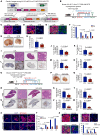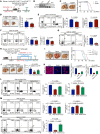Tumor-initiating cells escape tumor immunity via CCL8 from tumor-associated macrophages in mice
- PMID: 39774471
- PMCID: PMC11870738
- DOI: 10.1172/JCI180893
Tumor-initiating cells escape tumor immunity via CCL8 from tumor-associated macrophages in mice
Abstract
Tumor-initiating cells (TICs) play a key role in cancer progression and immune escape. However, how TICs evade immune elimination remains poorly characterized. Combining single-cell RNA-Seq (scRNA-Seq), dual-recombinase-based lineage tracing, and other approaches, we identified a WNT-activated subpopulation of malignant cells that act as TICs in vivo. We found intensive reciprocal interactions between TICs and immune-regulatory tumor-associated macrophages (Reg-TAMs) via growth arrest-specific 6/AXL receptor tyrosine kinase/MER proto-oncogene, tyrosine kinase (GAS6/AXL/MERTK) signaling pathways, which facilitated the immune escape of TICs. In this study, we used chemical inhibitors and Axl/Mertk conditional double-KO (cDKO) mice to demonstrate that inhibiting the interaction between TIC-derived GAS6 and AXL/MERTK in Reg-TAMs reactivated antitumor immune responses. We identified CCL8 as a critical mediator of the GAS6/AXL/MERTK pathway, primarily by inhibiting Treg infiltration into the tumor. Furthermore, the AXL/MERTK signaling blockade sensitized tumor cells to anti-programmed cell death 1 (anti-PD-1) treatment. Thus, we elucidated a detailed mechanism by which TICs evade tumor immunity, providing insights into strategies to eradicate TICs that escape conventional immunotherapy.
Keywords: Cancer immunotherapy; Oncology.
Figures







Similar articles
-
Axl and Mertk Receptors Cooperate to Promote Breast Cancer Progression by Combined Oncogenic Signaling and Evasion of Host Antitumor Immunity.Cancer Res. 2021 Feb 1;81(3):698-712. doi: 10.1158/0008-5472.CAN-20-2066. Epub 2020 Nov 25. Cancer Res. 2021. PMID: 33239426 Free PMC article.
-
A Functional Role of GAS6/TAM in Nonalcoholic Steatohepatitis Progression Implicates AXL as Therapeutic Target.Cell Mol Gastroenterol Hepatol. 2020;9(3):349-368. doi: 10.1016/j.jcmgh.2019.10.010. Epub 2019 Nov 2. Cell Mol Gastroenterol Hepatol. 2020. PMID: 31689560 Free PMC article.
-
Tyro3/Axl/Mertk-deficient mice develop bone marrow edema which is an early pathological marker in rheumatoid arthritis.PLoS One. 2018 Oct 18;13(10):e0205902. doi: 10.1371/journal.pone.0205902. eCollection 2018. PLoS One. 2018. PMID: 30335822 Free PMC article.
-
Post-translational modifications of the ligands: Requirement for TAM receptor activation.Int Rev Cell Mol Biol. 2020;357:35-55. doi: 10.1016/bs.ircmb.2020.09.002. Epub 2020 Oct 27. Int Rev Cell Mol Biol. 2020. PMID: 33234244 Review.
-
Immunological role of TAM receptors in the cancer microenvironment.Int Rev Cell Mol Biol. 2020;357:57-79. doi: 10.1016/bs.ircmb.2020.09.011. Epub 2020 Nov 3. Int Rev Cell Mol Biol. 2020. PMID: 33234245 Review.
Cited by
-
The immunomodulatory role of tumor-initiating cells in digestive system tumors: from mechanisms to therapy.Front Immunol. 2025 Jul 24;16:1621464. doi: 10.3389/fimmu.2025.1621464. eCollection 2025. Front Immunol. 2025. PMID: 40777043 Free PMC article. Review.
References
MeSH terms
Substances
LinkOut - more resources
Full Text Sources
Molecular Biology Databases
Research Materials
Miscellaneous

